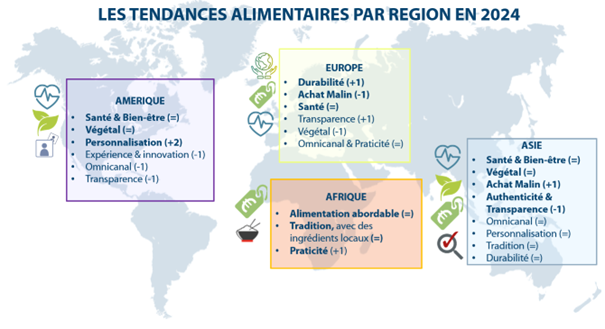[Webinar] Observatory of Global Food Trends 2024: we take stock!
The main key factors of change that will impact the agri-food value chain
In 2024, 6 external factors will be to follow with a direct and indirect impact important in agri-food.
-
Climate change
After a year 2023 marked once again by numerous episodes of drought, mega fires, extreme temperatures, 2024 should in all likelihood not be spared by future violent climatic events which will primarily impact agriculture and breeding. The commitments made with regard to the climate agreements also commit the means and objectives to be achieved for the entire sector.
-
Global geopolitics
2024 will be a high-risk year, due to the 70 elections scheduled → nearly 4.2 Billion of us will vote, or nearly one in 2 global citizens. These major deadlines include the elections for the European Parliament, the election of the prime minister in India, the Russian presidential election, the Mexican presidential election and the North American presidential election, all key nations on the global agricultural and food scene! Depending on the polls, a new world order will therefore take shape in 2024, with emerging objectives and possible tensions over the issue of food sovereignty. What about, in particular, in the EU, the revisions of the Green Deal/pacte Vert and the evolutions of the CAP?
- The global economic context
While headline inflation in 2024 should stabilise, few economists envisage deflation. Prices for food commodities will therefore remain at levels above those seen before 2023. Yet, at the same time, uncertainty remains overpredictions for growth and wealth creation. The economic indicators show a decrease in household purchasing power, which is negatively impacting food consumption in many countries, in the EU, the USA, Africa and Asia. Interest rates are also high, which may impair the investment capacity of companies in the industry and livestock farmers.
-
The energy market
Admittedly, the gas/electricity markets at the end of 2023-beginning of 2024 are expanding, but they remain by their very nature very volatile and uncertain. The factors mentioned above (including climate and geopolitics) can also cause prices to fluctuate sharply downwards or upwards. Yet our agri-agro sector is particularly dependent on the use of these energies in our factories as in livestock farming, with a significant impact on our production costs!
-
Health, disease and pandemics
Human diseases such as covid-19 and animal diseases such as avian influenza, swine fever and EHD in ruminants have had a significant impact on livestock production. Here too, changes in the health context will be a key point to monitor in 2024.
-
New technologies for analysing and exploiting data
2023 saw the large-scale deployment, across all industries, of generative AI. The use of these new applications and data analysis technologies has been democratised and aims to optimise or automate certain tasks, and accelerate the development of products and services, also in our agri/agro sector.
Global Food Trends to watch in 2024
The definition of food trends and their ranking is the result of a cross-analysis of expectations and changes in consumption practices, food product sales 2023, as well as food innovations launched in 2023.
Here is the 2024 expected ranking of the7 global macro food trends:
1. Sustainability (+1)
Consumers see their purchases as an act of citizenship and commitment to the planet, and favour sustainable food and practices.
2. Smart buying/consumption (-1)
Consumers are looking for affordable food, promotions/savings, and limiting food waste.
3. Health (=)
Consumers are increasingly interested in foods, diets and ingredients that improve immunity, health and well-being.
4. Transparency (+1)
Consumers want to know more about the food they eat: how is it produced? Where is it produced? By whom?
5. Plants and naturalness (-1)
Consumers have an interest in eating more plant-based diets and less meat-based, protein alternatives.
6. Omnichannel (=)
Consumers want to be able to buy and consume anything, anywhere, by any means and at any time.
7. Customisation (=)
Consumers want food that is perfectly aligned with their lifestyle, beliefs and needs.
Analysis: similarities and disparities in global food trends
The food trends mentioned above translate intoproduct innovations, new practices and consumption patterns that can be found all over the world. However, theprioritisation of these trends will differ whether we are looking at the North American, European, Asian or African markets.
In the map below, you'll find the ranking of food trends by big geographic region(as well as their evolution 2024 vs 2023).

READ MORE. Discover our expertise in relation to global food trends 2024

